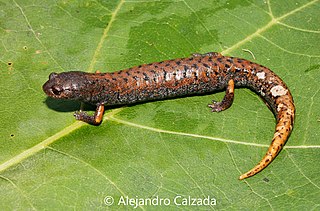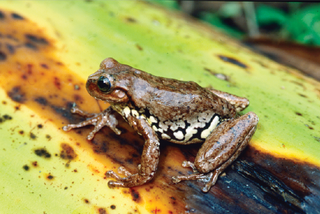
Xenosaurus is a genus of lizards; it is the only extant genus in the family Xenosauridae, with 14 species currently recognized. Also known as knob-scaled lizards, they can found in southwestern Tamaulipas and eastern Guerrero in Mexico. These lizards are known to feed on a variety of crawling and flying insects. This genus mostly eats orthopterans, coleopterans (beetles), dipterans, and myriapods.

Lepidophyma is a genus of lizards, commonly called tropical night lizards. The genus Lepidophyma is one of three genera of night lizards, which are a group of viviparous (live-bearing) lizards. There are 20 species of tropical night lizards in the genus Lepidophyma, making it the most populous night lizard genus. Species of the genus Lepidophyma are distributed throughout Central America, found anywhere from central Mexico to Panama, depending on the particular species. Tropical night lizards, particularly the yellow-spotted species, are sometimes called Central American bark lizards by pet dealers and owners.

Micrablepharus is a small genus of lizards endemic to South America.

Tantilla is a large genus of harmless New World snakes in the family Colubridae. The genus includes 66 species, which are commonly known as centipede snakes, black-headed snakes, and flathead snakes.

Charadrahyla is a genus of frogs in the family Hylidae. It is endemic to tropical southern Mexico. The generic name was derived from Greek charadra ("ravine") and Hyla, in reference to the habits of these frogs. Accordingly, common name ravine treefrogs has been coined for the genus.

Pseudoeurycea is a genus of salamander in the family Plethodontidae. The members of this genus are commonly known as the false brook salamanders. They are found in Mexico and Guatemala.

Rena is a genus of snakes in the family Leptotyphlopidae. The genus is endemic to the New World. All of the species were previously placed in the genus Leptotyphlops.

Geophis is a genus of snakes in the subfamily Dipsadinae of the family Colubridae of the superfamily Colubroidea. Species in the genus Geophis are commonly referred to as Latin American earth snakes. The genus consists of 53 distinct species.
Geophis immaculatus, Downs's earth snake, is a small snake of the colubrid family. It is native to Mexico and Guatemala. There are no recognized subspecies. Although not much has been documented about it, the population distribution is in abundance and is of least concern in terms of conservation status.
The giant blind snake is a species of snake in the family Leptotyphlopidae. The species is endemic to Mexico.
Jonathan Atwood Campbell is an American herpetologist. He is currently professor of biology at University of Texas at Arlington. He was a distinguished professor and chair of the Department of Biology, University of Texas at Arlington, Arlington, Texas.

This timeline of hadrosaur research is a chronological listing of events in the history of paleontology focused on the hadrosauroids, a group of herbivorous ornithopod dinosaurs popularly known as the duck-billed dinosaurs. Scientific research on hadrosaurs began in the 1850s, when Joseph Leidy described the genera Thespesius and Trachodon based on scrappy fossils discovered in the western United States. Just two years later he published a description of the much better-preserved remains of an animal from New Jersey that he named Hadrosaurus.

Apostolepis is a genus of snakes in the subfamily Dipsadinae. However, the familial placement differs among sources. It has also been placed in the family Colubridae, subfamily Dipsadinae or Xenodontinae, or in the family Xenodontidae. The genus Apostolepis is endemic to South America.
Hallberg's cloud forest snake, also known commonly as la culebra de bosque mesófilo de Hallberg in Mexican Spanish, is a species of snake in the subfamily Dipsadinae of the family Colubridae. The species, which is endemic to Mexico, is monotypic in the genus Cryophis.
The graceful mountain snake is a genus of snake in the family Colubridae.
Cenaspis aenigma is a species of colubrid snake in the subfamily Dipsadinae and the only member of the monotypic genus Cenaspis. It is endemic to the highlands of western Chiapas, Mexico, where it was described from a single, partially digested male specimen found in the stomach of a Central American coral snake. This is referenced in its generic name, as cena is Spanish for "dinner". Despite being partially digested, the specimen still displayed many unique traits, including undivided subcaudals for the full length of the tail, as well as a simple hemipenis completely covered in calyces with a largely non-bifurcated sulcus spermaticus. These traits are not known from any other colubroid snake in the Western Hemisphere.

Aspidoscelis sackii, known commonly as Sack's spotted whiptail, is a species of lizard in the family Teiidae. The species is endemic to Mexico. There are three recognized subspecies.

Sarcohyla is a genus of frogs in the family Hylidae. It is endemic to Mexico and is found in the montane parts of the country between Durango in the north and Guerrero in the south. These frogs typically occur in pristine habitats along streams in pine-oak woodland at elevations between 1,500 and 3,100 m above sea level. The generic name is derived from the Greek sarkodes meaning "fleshy" in combination with Hylas and refers to the thick, glandular skin characteristic of most of the species in the genus.
Anolis microlepidotus, the Guerreran oak anole, is a species of lizard in the family Dactyloidae. The species is found in Mexico.

Chersodromus liebmanni, also known commonly as Liebmann's earth runner and la corredora de Liebmann in Mexican Spanish, is a species of snake in the subfamily Dipsadinae of the family Colubridae. The species is endemic to Mexico.












